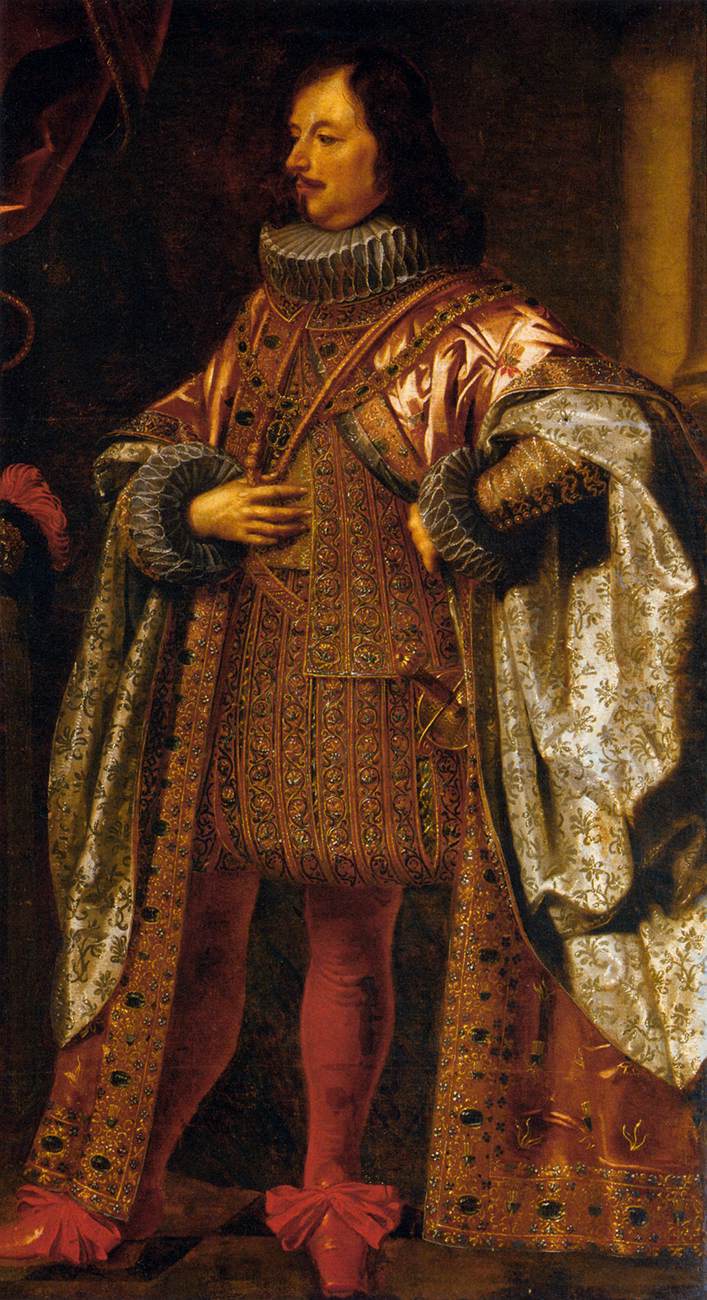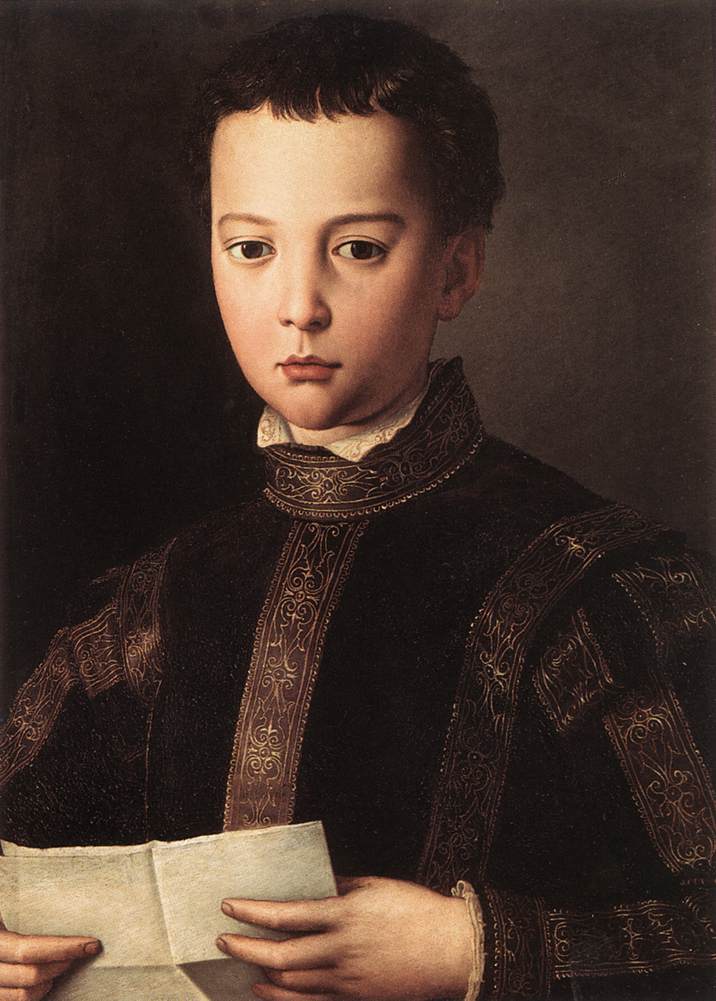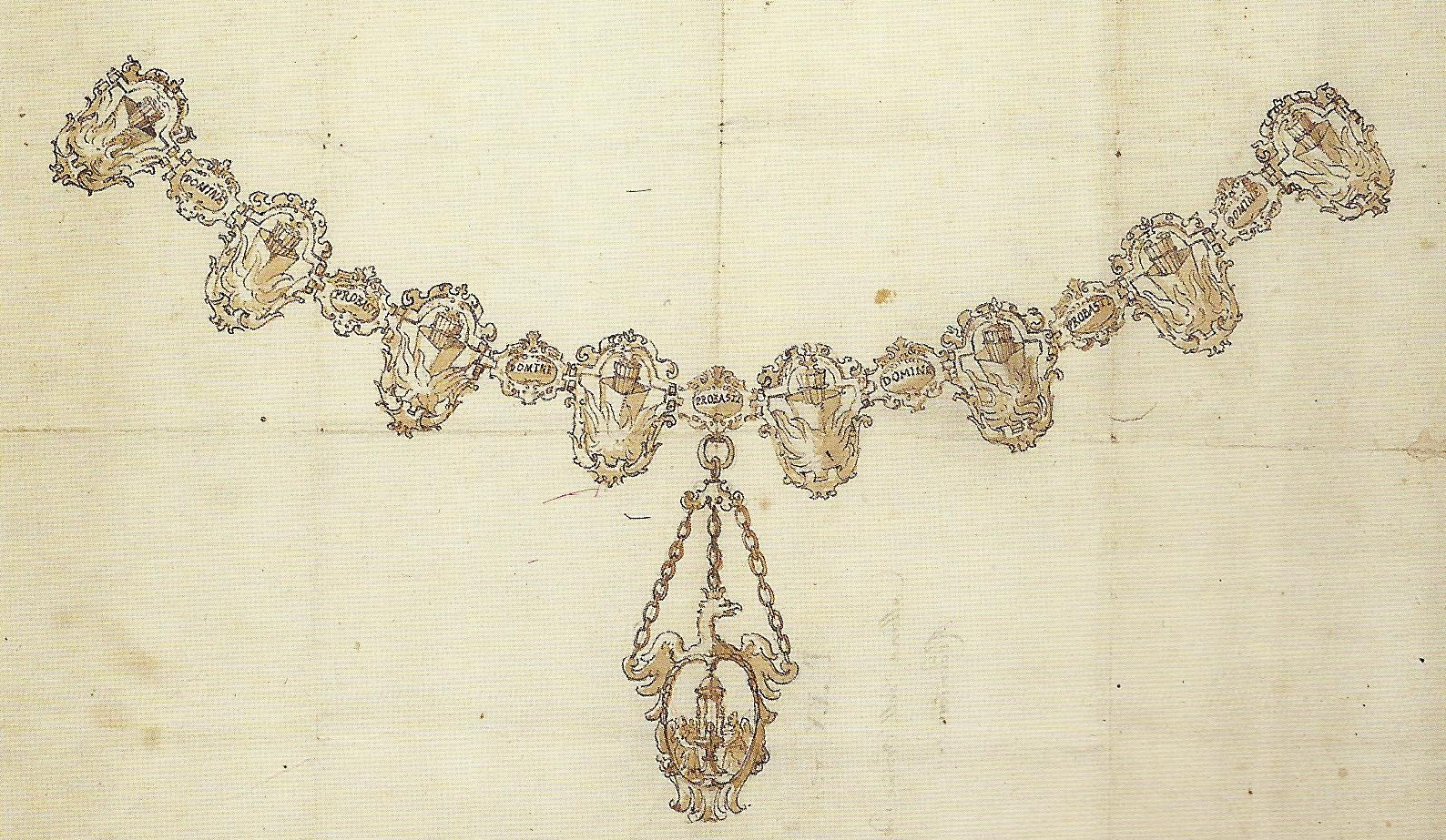|
Vincenzo II Of Gonzaga
Vincenzo II Gonzaga (7 January 1594 – 25 December 1627) was Duke of Mantua and Duke of Montferrat from 1626 until his death. Vincenzo was the son of Duke Vincent I and Eleonora de' Medici and inherited the duchy upon the death of his elder brother Ferdinand, receiving the imperial investiture on 8 February 1627. He had also received a cardinalate upon Ferdinando's succession, but had dismissed it in 1616 in order to marry his relative Isabella Gonzaga, daughter of Alfonso Gonzaga, Count of Novellara. Conscious of his poor health, the childless Vincenzo set up an inheritance for his lands through the marriage of his niece Maria (daughter of the former Duke Francis IV) with Charles of Nevers' son Charles of Gonzaga-Nevers. The elder Charles was a cousin of his father. Vincenzo died on the marriage day of Mary and Charles. Family Vincenzo II Gonzaga had no legitimate offspring from the wife, but he recognized four natural sons. By Paola Scarpelli: * Federico Gonzaga (1619 ... [...More Info...] [...Related Items...] OR: [Wikipedia] [Google] [Baidu] |
Duke Of Mantua
During its history as independent entity, Mantua had different rulers who governed on the city and the lands of Mantua from the Middle Ages to the early modern period. From 970 to 1115, the Counts of Mantua were members of the House of Canossa. During its time as free commune and ''signoria'' ("lordship"), the Lords of Mantua were exponents of the Bonacolsi and Gonzaga families. From 1328, Mantua was informally led by Gonzagas until 1433, when Gianfrancesco Gonzaga assumed the noble title of Marquess of Mantua. In 1530, Federico II received the title of Duke of Mantua. In 1531, the family acquired the vacant Marquisate of Montferrat through marriage. In 1627, Duke Vincent II deceased without heirs, ending the original line of Gonzagas. From 1628 to 1631, a succession war was fought between the Duke of Guastalla, supported by the Holy Roman Empire, and the Duke of Nevers, supported by France, for the control of the Duchy of Mantua. Finally, the Duke of Nevers was recognized ... [...More Info...] [...Related Items...] OR: [Wikipedia] [Google] [Baidu] |
Francesco IV Of Gonzaga
Francesco IV Gonzaga (7 May 1586 – 22 December 1612), was Duke of Mantua and (as Francesco II) Duke of Montferrat between 9 February and 22 December 1612. Biography Born in Mantua, he was the eldest son of Duke Vincenzo I and Eleonora de' Medici. In 1607, Claudio Monteverdi dedicated his opera ''L'Orfeo'' to Francesco. The title page of the opera bears the dedication "Al serenissimo signor D. Francesco Gonzaga, Prencipe di Mantoua, & di Monferato, &c." Francesco became Duke upon his father's death on 9 February 1612. He died at Mantua on 22 December 1612 without male heirs. He was succeeded by his brother Ferdinand; however, Charles Emmanuel I, Duke of Savoy, the father of Francesco's wife Margaret of Savoy, disputed this, leading to the War of the Montferrat Succession (1613–1617). Family On 19 February 1608 he married in Turin, Margaret of Savoy (1589–1655), daughter of Charles Emmanuel I, Duke of Savoy. They had: * Maria (29 July 1609 – 14 August 1660); married in ... [...More Info...] [...Related Items...] OR: [Wikipedia] [Google] [Baidu] |
Ferdinand I, Holy Roman Emperor
Ferdinand I ( es, Fernando I; 10 March 1503 – 25 July 1564) was Holy Roman Emperor from 1556, King of Bohemia, King of Hungary, Hungary, and List of rulers of Croatia, Croatia from 1526, and Archduke of Austria from 1521 until his death in 1564.Milan Kruhek: Cetin, grad izbornog sabora Kraljevine Hrvatske 1527, Karlovačka Županija, 1997, Karslovac Before his accession as Emperor, he ruled the Erblande, Austrian hereditary lands of the Habsburgs in the name of his elder brother, Charles V, Holy Roman Emperor. Also, he often served as Charles' representative in the Holy Roman Empire and developed encouraging relationships with German princes. In addition, Ferdinand also developed valuable relationships with the German banking house of Jakob Fugger and the Catalan bank, Banca Palenzuela Levi Kahana. The key events during his reign were the conflict with the Ottoman Empire, which in the 1520s began a great advance into Central Europe, and the Protestant Reformation, which resul ... [...More Info...] [...Related Items...] OR: [Wikipedia] [Google] [Baidu] |
Margaret Palaeologina
Margaret Palaeologa ( it, Margherita Paleologa; 11 August 1510 in Casale Monferrato – 28 December 1566 in Mantua), was the ruling Marquise regnant of Montferrat in her own right between 1533 and 1536. She was also Duchess of Mantua by marriage to Federico II, Duke of Mantua. Margaret acted as the regent of the Duchy of Mantua twice during the minority of her sons: for her elder son Francesco III Gonzaga, Duke of Mantua in 1540-1549, and for her younger son Guglielmo Gonzaga, Duke of Mantua, between 1550 and 1556. Early life Margaret was born in Casale to William IX of Montferrat and his wife Anne of Alençon. Margaret was the second of three children. Her elder sister was Maria Paleologa, who died when she was 21 years of age, and her younger brother was Boniface IV of Montferrat, who died when he was only 18 years of age. Marriage In 1517, Margaret's elder sister, Maria, was betrothed to Federico II Gonzaga, son of Francesco II Gonzaga and Isabella d'Este, who ... [...More Info...] [...Related Items...] OR: [Wikipedia] [Google] [Baidu] |
Federico II, Duke Of Mantua
Federico II of Gonzaga (17 May 1500 – 28 August 1540) was the ruler of the Italian city of Mantua (first as Marquis, later as Duke) from 1519 until his death. He was also Marquis of Montferrat from 1536. Biography Federico was son of Francesco II Gonzaga, Marquess of Mantua and Isabella d'Este. Due to the turbulent politics of the time, from the age of ten, he spent three years as a hostage in Rome under Pope Julius II. From 1515 to 1517, Federico was the hostage of King Francis I of France, to ensure Gonzaga assistance in Italy. On 3 April 1519, Federico succeeded his father as Marquis of Mantua, initially under the regency of his mother and his uncles Sigismondo and Giovanni Gonzaga. He received the imperial investiture from emperor Charles V on 7 April 1521. Pope Leo X named him Captain General of the Church (commander in chief of the Papal Army) in July 1521, and he fought against the French at Parma in 1521 and at Piacenza in 1522. Federico signed a marriage contract wit ... [...More Info...] [...Related Items...] OR: [Wikipedia] [Google] [Baidu] |
Joanna Of Austria, Grand Duchess Of Tuscany
Joanna of Austria (German ''Johanna von Österreich'', Italian ''Giovanna d'Austria'') (24 January 1547 – 11 April 1578) was an Archduchess of Austria. By marriage to Francesco I de' Medici, she was the Grand Princess of Tuscany and later the Grand Duchess of Tuscany. One of her daughters was Marie de' Medici, second wife of King Henry IV of France. Family Joanna was born in Prague, the youngest of 15 children, the youngest daughter of Ferdinand I, Holy Roman Emperor and Anna of Bohemia and Hungary. She never knew her mother and eldest sister as her mother died two days after Joanna's birth and her sister Elisabeth of Austria, Queen of Poland, died two years before Joanna was born. Her paternal grandparents were Philip I of Castile and Joanna of Castile. Her maternal grandparents were King Vladislaus II of Bohemia and Hungary, and Anna of Foix-Candale. Through her father, Joanna was also a descendant of Isabella I of Castile and Mary of Burgundy. Marriage Her marriage to ... [...More Info...] [...Related Items...] OR: [Wikipedia] [Google] [Baidu] |
Francesco I De' Medici, Grand Duke Of Tuscany
Francesco I (25 March 1541 – 19 October 1587) was the second Grand Duke of Tuscany, ruling from 1574 until his death in 1587. He was a member of the House of Medici. Biography Born in Florence, Francesco was the son of Cosimo I de' Medici, Grand Duke of Tuscany, and Eleanor of Toledo. He served as regent for his father Cosimo after he retired from his governing duties in 1564. Marriage to Joanna of Austria On 18 December 1565, Francesco married Joanna of Austria, youngest daughter of Holy Roman Emperor Ferdinand I and his wife Anne of Bohemia and Hungary. By all reports, it was not a happy marriage. Joanna was homesick for her native Austria, and Francesco was neither charming nor faithful. In 1578, Joanna died at the age of thirty-one, after falling down a flight of stairs while pregnant with their eighth child. Bianca Cappello Soon after Grand Duchess Joanna had died, Francesco went on to marry his Venetian mistress, Bianca Cappello, after aptly disposing of her ... [...More Info...] [...Related Items...] OR: [Wikipedia] [Google] [Baidu] |
Archduchess Eleanor Of Austria
Archduchess Eleanor of Austria (2 November 1534 – 5 August 1594) was Duchess of Mantua by marriage to William I, Duke of Mantua. She was the daughter of Ferdinand I, Holy Roman Emperor and Anna of Bohemia and Hungary. Life Eleanor was the eighth child and sixth daughter out of fifteen children born to Archduke Ferdinand of Austria (before his election as Holy Roman Emperor) and his wife Anna of Bohemia and Hungary. She was a sister of Johanna of Austria, who married Francesco I de' Medici, thus making Eleonora the aunt of Marie de' Medici, Queen of France. Life in Mantua She married William I, Duke of Mantua on 26 April 1561. At about age 5, Eleanor's daughter Anne Catherine became severely ill and nearly died. She contracted a high fever and her extremities began to swell. For two years she was ill. Finally Eleanor and William appealed to the Virgin Mary with deep prayer, promising to raise Anne as a child of Mary if she lived on. Soon Anne became healthy again. Eleano ... [...More Info...] [...Related Items...] OR: [Wikipedia] [Google] [Baidu] |
Guglielmo X Gonzaga, Duke Of Mantua
Guglielmo Gonzaga (24 April 1538 – 14 August 1587) was Duke of Mantua from 1550 to 1587, and of Montferrat from 1574 to 1587. He was the second son of Federico II Gonzaga, Duke of Mantua and Margaret Palaeologina of Montferrat. In 1574, Montferrat was elevated to a Duchy and Guglielmo became its first duke. He was succeeded as Duke of both duchies by his son Vincenzo. Patron of music Guglielmo was particularly interested in sacred vocal music, and is known particularly to music historians for his extensive correspondence with the composer Giovanni Pierluigi da Palestrina. He built a large new church in Mantua, dedicated to Santa Barbara. He engaged in an unprecedented negotiation with the Papacy to create his own rite for Mantua, and devoted considerable resources to developing a musical repertoire for the church, commissioning works by Giaches de Wert and Palestrina. Part of his correspondence with Palestrina discusses the work commissioned in detail, stipulating Guglielmo's r ... [...More Info...] [...Related Items...] OR: [Wikipedia] [Google] [Baidu] |
Vincenzo Gonzaga, Duke Of Mantua
Vincenzo Ι Gonzaga (21 September 1562 – 9 February 1612) was ruler of the Duchy of Mantua and the Duchy of Montferrat from 1587 to 1612. Biography Vincenzo was the only son of Guglielmo Gonzaga, Duke of Mantua, and Archduchess Eleanor of Austria. His maternal grandparents were Ferdinand I, Holy Roman Emperor, and Anna of Bohemia and Hungary. In 1582, Vincenzo murdered in cold blood the brilliant young Scottish polymath James Crichton, an employee of his father's court, of whom Vincenzo had become crazed with jealousy. Vincenzo was a major patron of the arts and sciences, and turned Mantua into a vibrant cultural center. On 22 September 1587, Vincent was crowned the fourth Duke of Mantua, with a glitzy ceremony in which were present the highest authority of the duchy to pay homage to the new Duke of Mantua: he then moved with a ride through the city streets. Vincenzo employed the composer Claudio Monteverdi and the painter Peter Paul Rubens. In 1590 Monteverdi became a viol- ... [...More Info...] [...Related Items...] OR: [Wikipedia] [Google] [Baidu] |
Blood Of Jesus Christ (military Order)
Blood of Jesus Christ, or Blood of Christ, was a military order instituted at Mantua by Vincenzo I Gonzaga, Duke of Mantua, approved on 25 May 1608 by Pope Paul V. The motto of the order was ''Domine probasti me'', or that ''Nihil hoc triste recepto''. Jean Hermant speaks of the order and observes that it took its name from some drops of the blood of Jesus, said to have been preserved in the cathedral church of Mantua. Their number was restricted to twenty besides the Grand Master; the office whereof was attached to himself and his successors. There was also a congregation of nuns in Paris, France, called Blood of Jesus Christ, reformed from the Cistercians. History Vincenzo I Gonzaga was a member of the chivalry equestrian order of Toson d'Oro. He had been given the honour of being part of this order of knighthood by the Grand Master Philip the second, King of Spain in 1589 after paying the enormous amount of 300,000 golden escudos. Not yet happy with that, he decided t ... [...More Info...] [...Related Items...] OR: [Wikipedia] [Google] [Baidu] |
MAN Order Blood Jesus Christ
A man is an adult male human. Prior to adulthood, a male human is referred to as a boy (a male child or adolescent). Like most other male mammals, a man's genome usually inherits an X chromosome from the mother and a Y chromosome from the father. Sex differentiation of the male fetus is governed by the SRY gene on the Y chromosome. During puberty, hormones which stimulate androgen production result in the development of secondary sexual characteristics, thus exhibiting greater differences between the sexes. These include greater muscle mass, the growth of facial hair and a lower body fat composition. Male anatomy is distinguished from female anatomy by the male reproductive system, which includes the penis, testicles, sperm duct, prostate gland and the epididymis, and by secondary sex characteristics, including a narrower pelvis, narrower hips, and smaller breasts without mammary glands. Throughout human history, traditional gender roles have often defined an ... [...More Info...] [...Related Items...] OR: [Wikipedia] [Google] [Baidu] |



_-_Francesco_Francia.jpg)





.jpg)